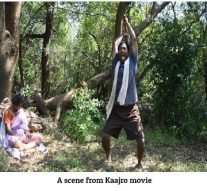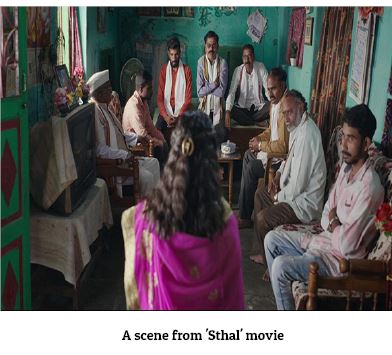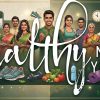Goa is abuzz with excitement as vintage bike and car owners, users, collectors and fans are decking […]

AFTER 79 YEARS IF INDEPENDENCE…
Aug 23- Aug 29, 2025, Life & Living August 22, 2025A Konkani film titled “Kaajro” at the Goa State Film Festival shook up my soul like no other film.
IT’S been a run up of festivals with more on the way, we’re a country of festivals like no other. Even if after 79 years of independence we haven’t got our public infrastructure stream lined or for that matter the attitudes we bring to life cleaned up at least in how we perceive our untouchable people at the bottom of the ladder of so called high caste society! If you live in Goa or want to live in Goa we must redress all that is wrong in the deep countryside village Goa where time still stands still despite 550 years of Portuguese colonial rule and some 65 years of independence since the first chief minister of Goa brought the education of liberation to the doorstep of the Bhandari samaj. But after that, what?
One of these days watch De Goa Studio’s Konkani film “Kaajro” (“A Bitter Tree”), it recounts the utterly poignant story of a Tilgya, a man of all purpose use as in the lowest of the low in the caste system’s hierarchy. We need them to pay dholak with wonderful artistry (like prayers to whichever devta or devi tribal or of the Hindu pantheon) and other temple and rites of upper caste society – but everyone takes the low castes for granted treat them like invisible or there only to shooed away, kept at a distance or taken advantage of.
Young Tilgya is a quiet man who keeps his thoughts to himself or perhaps doesn’t even think beyond a point (for that is a luxury he cannot afford), the higher castes have to be imperial…he dies day by day in the painful silences of his miserable life.
Tilgya’s wife is sick, tuberculosis may be, and no amount of medication he manages to get for her makes her better; she dies on Dassera day when the temple needs him to pound his drum…nobody in the village let alone the village Panchayat chief is willing to give him a piece of land in the village to bury his wife. In fact he is ordered to carry her dead body out of the village and bury her near a kaajro tree (a most reviled tree with everything about it bitter).
So we have stunning portrait of a man sweet talking his dead wife as he lugs her on his back all the way out into the jungle, wading across a stream which had taken his parents away from his during a flood. He tells his wife in her next life it would be better if she takes birth as a wild animal or a bird but never as a human being to live the kind of humiliating life he could provide her with…he reaches the kaajro tree, decides to bury his wife amidst the sweetness of happier ground nearby.
Taking a last close look at his wife’s dead body and face he sees there’s a copper coin wrapped in one tight fist, she thought it was made of gold and should be handed down from generation to generation…her only good-luck charm given to her by her grandmother. He breaks down now and here’s such sweet love, loss, quiet emotions, blowing apart the deeply entrenched cruelties of a caste-obsessed mindset, which makes the better-offs look down yet exploit the marginalized in society.
The story of one Tilgya is the story of so many other Tilgyas and I found myself asking why in our times we should have to see a film as heartbreaking as this one, a film which brings tears to a most hardened heart! You’d think after 79 years of independence our idiotic caste-riddled mindset would have given way to more educated, kinder, sensitive ways of thinking — but here in the Nitin Bhaskar directed and magnificently choreographed and photographed we see what’s closer to the truth, a most bitter harsh truth. You have to see “Kaajro” if it comes up in the International Film Festival of India coming up in November later this year. The film’s producer is Rajesh R Pednekar.
AMONGST the other films I managed to select on my own to see early in the 4-day festival of Konkani cinema — which has a long innings courtesy its relationship with the Mumbai-based Hindi cinema, and a lot of Konkani cinema finds its grounding in Konkani tiatr or drama which had moulded the Goan social conscience for centuries – were “7Days” and amongst the non-feature shorter films there were “Waghro,” “Goy: Swatantyryache Homkhan” and “Gathan.” “Waghro” (De Goan Studio production) is just a short 9 min plus take about a young couple in love but the boy who’s from the lower strata of society tells her to run away with him, for the village is akin to a “prison” for him where people still expect him to do certain lower caste jobs – they wealthier genteel folk don’t see him as human as them, in a big city he might find a future for himself. The girl refuses to elope with him but watches him leave when the ferry arrives to cross the river…and who know what will happen to her! A real cameo of a film with producer Rajesh introducing the cast of the film, that sometimes doing a short film is much harder than doing a feature film! “Waghro” etches itself in memory and reminds me of what Mahatma Gandhi once said, if you want to develop and progress all around, begin bottoms up from the villages of India. Really, it’s regional films like some of those screened at this 10TH, 11TH, 12TH edition of GSFF which bring one down to earth instead of living in the lulu land of our urban lifestyles of plenty of everything and little else or so to peak.
REALLY sensitive films in touch with the ground realities of life at the bottom of the pyramid of the good life are few and far between and they tend to haunt one if one’s conscience is still alive. Today’s younger filmmakers like most others in different areas of earning a livelihood are usually seeking means and ways to get rich quick – fortunes one’s parents or grandparents may have worked half-a-lifetime or more to earn! Some of today’s films reflect this and infuse so much of what I call PFTD (paise feko tamasha dekho) entertainment that gives me a headache! Mercifully, now I have learned to walk out of a film in the first 10 minutes if nothing about the fill jells with me.
Usually I take in women-oriented films of which there are many today — for women’s lives offer so much “bheja fry” food for creativity! A film from the earlier Goa Marathi Film Festival (GMFF) which happened August 9-10 is still haunting me. Marathi cinema is very dynamic and Dhun Productions “Sthal” (translating as “Match” or proposal) is still haunting me. This debut film from director Jayant Digambar Somalkar is about a young village student Savita (Nandini Chikte), more anxious to finish her college education than get married as her parents wish. It’s a most insightful film raising so many questions about how much agrarian communities in Maharashtra have progressed on the subject of daughters.

Savita situation is most poignantly even as anger brews in her. On the surface of it she patiently entertains proposals which the village matchmaker brings to the family for her… a devastating repeat scenario of boy’s family members dropping in for tea, snacks, bride in question mark seated before them, answering the usual …how old are you, how tall are you, , how educated, what hobbies, half-a-dozen standard questions. Tea party over they depart saying they will revert. In this case the Savita is too dusky or not tall enough or this, that and the other for the groom. So it continues ad nauseaum as Savita continues to pursue her studies, curiously is taken up by a college teacher who takes a keen interest in her…his family turns up with a proposal, but they want Rs5 lakh for an educated groom! The hypocrisy of the educated is galling and Savita’s morale shatters, she expected something better from one who professed “empowering women” in his classes.
Next proposal, please. And that’s when something boils and she gets up to…slap her questioner. End of film. The sound of the slap resonated so loudly it rang in the ears and believe me, the entire audience watching in the audi stood up and clapped in approval! Please catch this film, the finale is still echoing in my mind. “Sthal” is unforgettable, the film offers a painful and powerful glimpse of what’s happening in rural society in Maharashtra, a state which sees such grim statistics of farmers’ death. The film left me wondering if the state of Maharashtra has had a government at all in these last 79 years, that is beyond the city of Mumbai?
WHEN the 56th International Film Festival of India (IFFI) comes up in November later this year in Goa, I’ve made up my mind for a change to see more regional films. Usually, I concentrate on the films of USA or the Europe or Africa films. Fact is I find our films way too long, oftentimes meandering on self-indulgently for two to three hours. I tend to avoid them. Plus, if there’s a red carpet presentation and introduction of film cast before film screening, one is sitting longer than desirable in an audi.
Our presenters and VIPs love the sound of their voice and don’t know how to be brief or to the point when necessary, reduce two minutes to one! Presenters don’t begin by introducing themselves, “I am so and so”… so that audience know who is addressing them — I mean everyone doesn’t know exactly, it is only polite to introduce oneself even if one may imagine the whole world recognizes one. There’ll always be the odd fools who don’t.
On that note it’s avjo, selamat datang, poite verem, au revoir, hasta la vista, vachun yetta here for now. Here’s to more books and more films to grow up and keep growing up till doomsday!
Films screened…
THE 10th, 11th and 12th edition of Goa State Film Festival held from August 14 to 17, 2025 showcased Goan regional language, namely Konkani and Marathi films. There were 21 awards in the feature film section and seven awards in the non-feature section, these awards saw competition from 19 feature films and four non-feature films.
The 19 feature films competing included “Questaio de Confusao,” “Miranda House,” “Kaajro,” “7 Dayz,” “Juze,” “Amori” (Dusk), “Chopadi,” “Glory,” Mopa Diary,” “Amizade,” “Bade Abbu,” “D’Costa House,” “Pedru Poder,” “Ransaavat,” “Fotting No.1,” “Gang,” Tem” (Battle of Egos), “Crazy Mogi,” “MOG.”
The four non-feature films in competition included:
“Wagro,” “Goy: Swatantryache e Homkhan,” “Gathan” and “Kupamcho Daryeo.”
48 hours short film competition winners…
Best Film–1ST Prize: “Ful Ani Savli” (Flower and Shade)
Best Film –2nd Prize: “Before Sunrise”
Best Director: Glen Cardozo (“Ful Ani Savli”)
Best Cinematographer: Tejas V Naik (“Ful Ani Savli”)
Best Editor: Yuri B Carvalho (“Ful Ani Savli)
Best Actor (Male): Niraj Arrie (“Life”)
Best Actor (Female): Rati Bhatikhar (“Ful Ani Savli”)














